| Basic Research | https://doi.org/10.21041/ra.v11i3.552 |
Evaluation of the effect of waste clay from a polyol production process as a partial substitute for cement in reinforced concrete
Avaliação do efeito da argila residual de um processo de produção de poliol como substituto parcial do cimento em concreto armado
Evaluación del efecto de la arcilla de desecho de un proceso de producción de polioles como sustituto parcial del cemento en concreto armado
O.
Troconis de Rincón1
*
![]() , V. Millano1
, V. Millano1
![]() , W. Suarez1, L. Navarro1, A. De Turris1, R. Amesty1
, W. Suarez1, L. Navarro1, A. De Turris1, R. Amesty1
1 Centro de Estudios de Corrosión, Facultad de Ingeniería, Universidad del Zulia, Maracaibo, Venezuela.
*Contact author: oladistdr@gmail.com
Reception: July 11, 2021.
Acceptance: August 21, 2021.
Publication: September 01, 2021
| Cite as: Troconis de Rincón, O., Millano, V., Suarez, W., Navarro, L., De Turris, A., Amesty, R. (2021), "Evaluation of the effect of waste clay from a polyol production process as a partial substitute for cement in reinforced concrete", Revista ALCONPAT, 11 (3), pp. 50 – 63, DOI: https://doi.org/10.21041/ra.v11i3.552 |
Abstract
In this work, the effect of waste clay from a polyol production process was evaluated, as a partial substitute for cement in reinforced concrete, in concentrations of 0%, 5% and 10%. The physico-mechanical characteristics of the concrete and the electrochemical properties of the steel were determined during a period of 356 days (ISO 11474), in 15x10x5 cm specimens, with two steel bars embedded in the concrete. The results indicate that the compressive strength decreased proportionally according to the clay content; increasing for 90 days of curing. However, the capillary sorption of the concrete decreased, which allowed the steel in the marine environment to maintain its passive state for longer than its blank specimen, for the w/c ratios evaluated (0.45 and 0.60).
Keywords:
corrosion in reinforced concrete,
cement replacement,
polyolica clay,
durability.
Resumo
Neste trabalho foi avaliado o efeito da argila residual de um processo de produção de polióis, como substituto parcial do cimento em concreto armado, nas concentrações de 0%, 5% e 10%. As características físico-mecânicas do concreto e as características eletroquímicas do aço foram determinadas durante um período de 356 dias (ISO 11474), em corpos de prova de 15x10x5 cm, com duas barras de aço embutidas no concreto. Os resultados indicam que a resistência à compressão diminuiu proporcionalmente com o teor de argila; aumentando para os 90 dias de cura. No entanto, a sorção capilar do concreto diminuiu, o que permitiu ao aço em ambiente marinho manter seu estado passivo por mais tempo do que suas metas, para as relações a/c avaliadas (0,45 e 0,60).
Palavras-chave:
corrosão em concreto armado,
substituição do cimento,
argila polióis,
durabilidade.
Resumen
En este trabajo se evaluó el efecto de la arcilla de desecho de un proceso de producción de polioles, como sustituto parcial del cemento en concreto armado, en concentraciones del 0%, 5% y 10%. Se determinaron las características físico-mecánicas del concreto y electroquímicas del acero durante un periodo de 356 días (ISO 11474), en probetas de 15x10x5 cm, con dos barras de acero embebidas en el concreto. Los resultados indican que la resistencia a la compresión disminuyó proporcionalmente según el contenido de arcilla; incrementándose para los 90 días de curado. Sin embargo, la sorción capilar del concreto disminuyó, lo cual permitió que el acero en ambiente marino mantuviera su estado pasivo por más tiempo que sus blancos, para las relaciones a/c evaluadas (0,45 y 0,60).
Palabras clave:
corrosión en concreto armado,
sustitución del cemento,
arcilla poliolica,
durabilidad.
1. Introduction
Concrete is the most consumed man-made material in the world (Ghosal, 2015), being a mixture of basically four components; coarse aggregate (gravel), fine aggregate (sand), water and cement. The latter represents the highest economic and environmental cost because its production is one of the largest sources of greenhouse gases, contributing 7 to 8% of these gases (Devi et.al., 2016). The widespread use of cement is due to its versatility, durability, and low maintenance when compared to other commonly used construction materials such as steel, wood, bricks, etc.
In recent decades, efforts have been made to focus on finding materials that partially replace cement in the preparation of concrete, in order to reduce the aforementioned economic and environmental impact. Such efforts have led to the evaluation of different materials among which are: blast furnace ash, marble and granite (Devi et.al., 2016), rice shell ash (Ghosal, 2015), tile dust (Manogna and Srilakshmi, 2015), egg shells (Gowsika et.al., 2014), nickel slag (Montiel, 2012), shrimp shell (Mendoza et.al., 2013), among many others. All these materials have in common being some type of waste from a process other than cement production, so their addition, as a partial substitute for cement in a concrete mix, represents the elimination of an environmental liability. Common elements in these materials are silicates, such as calcium and magnesium silicate, which increase the possibility of pozzolanic activity in these wastes. This type of siliceous or silico-aluminous materials are called natural pozzolans, which, although by themselves have little or no cementing value, react chemically with one of the reaction products of cement in contact with water, portlandite or calcium hydroxide (Ca(OH)2), which at ordinary temperatures forms compounds with cementitious properties (ASTM C 618-89).
Now, in the Petrochemical industry, there are many processes that produce substances that generate well-being for society, however, they might also generate large amounts of undesirable substances that constitute an environmental liability, which must be disposed of in accordance with the current legal framework (Decree 883. Venezuelan environmental regulations) to be disposed of in soil, air and bodies of water. The production of polyurethanes is one of them, which leaves the accumulation of a residue from the polymerization reaction of the monomers of ethylene and propylene oxides. The waste, known as waste clay, is a mixture of magnesol (synthetic hydrated magnesium silicate), filter material and impregnated polyol, previously used as secondary raw material in the process to deactivate the catalyst (KOH), from the polymerization reaction by means of catalytic adsorption. Reusing this liability, it can help conserve natural resources, by disposing of waste and reducing the demand for conventional raw materials for other production processes.
The characteristic high content of magnesium silicates in Magnesol would be expected to provide remarkable compressive strength as a partial replacement for cement in concretes. In the same way, the alkaline reserve would be favored by the presence of KOH, used as a catalyst, a condition that would benefit the passivation of the reinforcing bars (Oxiteno Andina, 2000).
Thus, the objective of this work was to evaluate the effect of polyol waste clay as a partial substitute for cement, in the preparation of reinforced concrete. This, in order to reduce the consumption of cement, maintaining at least the durability of the concrete without the addition; and also obtaining an economic and ecological benefit, which has not been investigated so far.
2. Experimental procedure
2.1 Mineralogical characterization of polyol clay
This test was carried out to determine the chemical components that make up the discarded clay from polyol production. To this end, the X-ray spectrometry analysis technique and X-ray fluorescence (XRF) were used. However, due to the caked nature (with polyol residues) of the clay sample, a treatment prior to the application of these test methods was necessary, which consisted of a physical separation of the waste clay from the remaining bulk mass of polyols. The separation process consisted of separating the filter material made up of the powdered mixture of Magnesol and filter aid or rare earths, by means of the total dissolution of the waste impregnated in polyols in an organic solvent such as acetone. Subsequently, the stripping with nitrogen was carried out using a vertical trays filter, which retains the Magnesol-filter aid mixture and the KOH catalyst residue in dry powder; allowing most of the polyol dissolved in acetone to pass through. The dry base of the waste clay (Magnesol, filter aid and KOH) hereinafter polyol clay powder, was subjected to the following tests.
2.2 Physicochemical characterization of polyol clay
2.3 Mix design
The mix design that was used in the manufacture of the specimens for the tests, contemplated two w/c ratios of 0.45 and 0.60. These mixtures were designed in accordance with ACI 211.1.1991.
2.4 Preparation of specimens
Table 1 shows the number of specimens and dimensions, according to the type of test to be carried out:
| Table 1. Distribution of the specimens for the different tests to be carried out. | ||||||||||||||
| Test specimen | Programmed test | |||||||||||||
|---|---|---|---|---|---|---|---|---|---|---|---|---|---|---|
| 18 cylinders 10x20 cm | • Capillary sorption | |||||||||||||
| • Natural Diffusion (D3) | ||||||||||||||
| • Exposition to a natural urban environment | ||||||||||||||
| 36 cylinders 15x30 cm | • Compressive strength | |||||||||||||
| • Resistivity | ||||||||||||||
| 18 prismatic specimens | • Corrosion Potential | |||||||||||||
| • Corrosion Rate | ||||||||||||||
2.5 Compressive strength test
After a curing period of 28 and 90 days, under conditions of high relative humidity (test specimens wrapped in newspaper and saturated with water) and room temperature (≤ 25 °C), the test was carried out according to the ASTM C39/C39M- standard. 2012
2.6 Determination of capillary sorption.
Concrete slices of 5 cm thick and 10 cm in diameter were used to carry out this test. The test was based on the procedure described in the DURAR manual (Troconis de Rincón, et.al., 2011), which at the same time it was based on the methodology proposed by Fagerlund (1982) that describes the kinetics of capillary sorption through three coefficients: m (resistance to water penetration), k (capillary sorption coefficient) and εe (effective porosity).
2.7 Determination of the carbonation front
The specimens were exposed to an urban environment for 82 days (28 °C and 400 ppm CO2). Once the specimen was selected, a cross-section cut was made to each one of them and, with its surface free of dust, phenolphthalein (acid-base indicator) was applied by atomization in a uniform way, as indicated in the DURAR manual (Troconis de Rincón, et.al., 2011); thus measuring the carbonate thickness with the use of a caliper.
2.8 Electrochemical evaluation of test pieces exposed to an accelerated marine environment according to the modified ISO 11474 standard.
The corrosion potential was determined twice a week on the reinforcement of the prismatic specimens, using a saturated Cu/CuSO4 reference electrode and a multimeter. Each prismatic specimen has two carbon steel bars embedded in the concrete, identified as A and B, located 1.5 cm from the exposed face.
Regarding the corrosion rate measurements over time, they were carried out using the Gecorr10 equipment, using the polarization resistance technique. The frequency of corrosion rate measurements was 1 to 2 times per month.
3. Results
3.1 Mineralogical and chemical characterization
The X-ray fluorescence (XRF) test results shown in Table 2 reveal the mineralogical composition of the polyol waste clay powder; discovering that the major constituent is silicon oxide (SiO2) with 64.86%, followed by potassium oxide (K2O) with 24.82% and finally magnesium oxide (MgO) with 5.7%, all expressed on a mass basis.
| Table 2. Mineralogical composition (oxides) of polyol clay by XRF. | ||||||||||||||
| REFERENCE | SiO2 | K2O | MgO | Al2O3 | SO3 | Fe2O3 | TOTAL | |||||||
|---|---|---|---|---|---|---|---|---|---|---|---|---|---|---|
| SAMPLE | 64.86 | 24.82 | 5.7 | 3.02 | 0.82 | 0.79 | 100.01 | |||||||
In these results, the absence of calcium or its oxide within the composition of the clay is observed. This is not only essential for the formation of calcium silicates, whose reaction with water produces hydrated calcium silicates responsible for the compressive strength of concrete, but also for its alkalinity; which influences its durability. The high concentration of SiO2 would promote the formation of these silicates if there was a source of Calcium. This source can come from the cement itself, since one of the products of the hydration reaction of calcium silicates is calcium hydroxide. However, as mentioned before, the waste used in the manufacture of concrete is a clay impregnated in polyol, with a pasty appearance. The equipment and techniques used for its analysis only accept powder samples, which is why the waste was separated from the polyol by washing with an organic solvent (Acetone). As a result of this separation process, 51.9% of the sample is made up of polyol, which has a viscous appearance, comparable to oil, and the remaining 48.1% by weight is made up of the filter material (Magnesol, Filter aid and KOH), this is a very fine white powder, which will be later identified as “clay powder”. Because polyol represents more than 50% of the waste used in the manufacture of concrete, the impact of this dust on the durable properties of concrete cannot be predicted based on the mineralogical composition / chemical analyzes presented.
Table 3 compares the mineralogical composition of the polyol waste clay with that found in the type II portland cement, used in this investigation, by means of X-ray spectrometry. The clay powder is basically composed of magnesium silicate (magnesol), with 72.88% of SiO2 that could be capable of reacting with free lime (CaO) forming hydraulic compounds that contribute to the development of the mechanical resistance of concrete, that is to say that this concentration range could cause a positive impact by producing long-term pozzolanic activity (Calleja, 1983). Additionally, it is observed that the alkali and MgO content of the powder is high, which could negatively influence the mechanical properties of concrete.
| Table 3. Chemical constituents present in Portland cement and polyol waste clay used to make concrete. | ||||||||||||||
| Reference Component | Polyol manufacturing waste (Powder clay) | Portland II cement | ||||||||||||
|---|---|---|---|---|---|---|---|---|---|---|---|---|---|---|
| L.F | 2.18 | 3.46 | ||||||||||||
| SiO2 | 72.88 | 20.16 | ||||||||||||
| Al2O3 | 1.05 | 4.23 | ||||||||||||
| Fe2O3 | 0.03 | 3.05 | ||||||||||||
| CaO | 1.12 | 64.38 | ||||||||||||
| MgO | 9.63 | 0.87 | ||||||||||||
| SO3 | 0.90 | 1.87 | ||||||||||||
| K2O | 9.04 | 0.47 | ||||||||||||
| TiO2 | 0.12 | 0.26 | ||||||||||||
| Mn2O3 | 0.01 | 0.37 | ||||||||||||
| Na2O | 2.14 | 0.00 | ||||||||||||
| Total | 99.10 | 99.12 | ||||||||||||
| L.F. Lost to Fire | ||||||||||||||
When analyzing the amount of chloride ions in the polyol waste clay, it was found that it was low (338.85 ppm), which does not affect the durability of the rebar.
3.2 Pozzolanic activity
Following the guidelines of the ASTM C-311 standard, the degree of pozzolanity of the polyol waste clay in the manufacture of mortars was studied. For this, the compressive strength values of a mortar with substitution (20% polyol clay) were compared against a blank specimen. The results in Table 4 show that the polyol waste clay exhibits a pozzolanity activity index of 58.34% as a function of its compressive strength. The results in Table 4 also show the limited pozzolanic nature of the waste clay; since it does not exceed the 75% established by the ASTM C311. Since the pozzolanic action is an interaction phenomenon in which the surface (total and specific) of the active material greatly influences, it must be ground to great fineness or possess it by itself, in any case, it must be much finer than clinker. In this case, the material used in the research, (dry clay without the polyol), despite having high SiO2 content does not have the specified texture to develop pozzolanic action, because the polyol constitutes 51.9% of the material, turning it into a viscous-looking mass, and preventing the interaction of the active surface of the material with the phases and hydration products of the cement.
| Table 4. Pozzolanity activity of polyol waste clay. | ||||||||||||||
| Pozzolanity activity index test (ASTM C-311) | ||||||||||||||
|---|---|---|---|---|---|---|---|---|---|---|---|---|---|---|
| Pozzolanity activity index, % | 58.34 | |||||||||||||
| Strength, kg/cm2 | ||||||||||||||
| Blank | 314.64 | |||||||||||||
| Substituted Mortar | 183.57 | |||||||||||||
| Air content, % | 13.95 | |||||||||||||
| Fluidity, % | 81.84 | |||||||||||||
| Water Requirement, % | 82.64 | |||||||||||||
3.3 Mix design
To prepare the mix design, the procedure described by the ACI C211.1.1991 standard for water/cement ratios (w/c) of 0.45 and 0.60 was followed. Based on this, it was designed for compressive strengths of 380 Kgf/cm2 and 260 Kgf/cm2 for w/c of 0.45 and 0.60, respectively, and a slump of 10 ± 2 cm. Table 5 shows the results of the mix design for 1 m3 of concrete, for the mentioned w/c ratios.
| Table 5. Mix design for 1 m3 of concrete for w/c ratios of 0.45 and 0.60 and slump of 10±2 cm. | ||||||||||||||
| w/c (Ratio) | 0.45 | 0.60 | Unit | |||||||||||
|---|---|---|---|---|---|---|---|---|---|---|---|---|---|---|
| Substitution % | Blank | 5% | 10% | Blank | 5% | 10% | - | |||||||
| Mix water | 202.51 | 202.51 | 202.51 | 197.71 | 197.71 | 197.71 | kg/m3 | |||||||
| Cement content | 450.02 | 427.52 | 405.02 | 323.23 | 307.07 | 290.91 | kg/m3 | |||||||
| Polyol waste clay content | 0 | 22.501 | 45.002 | 0 | 16.16 | 32.32 | kg/m3 | |||||||
| Corse aggregate content | 886.49 | 886.49 | 886.49 | 919.72 | 919.72 | 919.72 | kg/m3 | |||||||
| Fine aggregate content | 793.46 | 793.46 | 793.46 | 888.61 | 888.61 | 888.61 | kg/m3 | |||||||
3.4 Evaluation of the fresh mix
Figure 1 shows that for mixtures with clay addition, an increase in workability proportional to the increase in clay is observed as a partial replacement for cement (13-14cm, 21cm and 23-24cm slump for 0%, 5% and 10%, respectively). However, in none of the evaluated cases (with/without clay), significant differences were observed between the mixtures with w/c ratios of 0.60 and 0.45; which may be due to the excellent quality of the aggregates used.
For the 0.45 and 0.60 mixtures with 5% substitution, a slump of 21 cm was recorded for both fresh mixtures, with an approximate increase of 8 cm with respect to the values recorded for the reference mixtures (blanks). For the 0.45 and 0.60 mixtures with 10% substitution, 23 and 24 cm of settlement were recorded, respectively, with an increase of 10 cm compared to their reference mixtures. These results show an effect on the workability of the fresh mix due to the addition of clay as a partial substitute for cement, the effect being more noticeable with respect to blank specimens for the lower dosages of clay, since the difference in workability of the mix between 5 and 10% substitution is minimal (2 cm slump approximately).
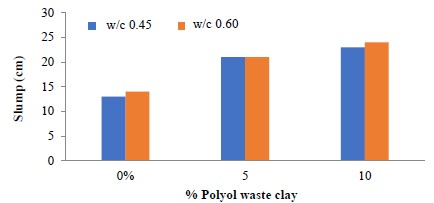 |
||||
| Figure 1. Results of the slump test in concrete fresh mix. | ||||
These results show the increased plasticizing property on the fresh mixture, apparently contributed by the polyol, which, since it is a branched polymer with an approximate molecular weight of 3500 g/mol and which constitutes 51.9% by weight of the polyol waste clay, softens and provides greater workability without the need to add water. This is especially beneficial in mixtures with a low w/c ratio, which by nature have poor fluidity and are difficult to work with, providing greater workability without the need to modify the w/c ratio and maintaining the durable properties of concrete.
3.5 Compressive strength test
For w/c = 0.45 (Figure 2), a decrease in compressive strength is observed proportional to the increase in clay concentration. For 28 days of curing, only the blank specimen managed to reach the design resistance. On the other hand, for the 90 days of curing a slight increase in this typical property of mature concrete was observed; even though the polyol clay concretes increased their compressive strength a little more (16% compared to 11% for the blank). However, none of the substituted mixes achieved design strength. The same behavior was obtained for w/c = 0.60 (Figure 3), where only the blank specimen managed to achieve the design compressive strength. It has been determined (Smaoui, et.al., 2005) that the increase in the alkali content in the mix can decrease the compressive strength of concrete. However, even when the K2O content is very high in the ash (Table 3), the equivalent Na2O is <0.6 for both mixtures; which would not affect the compressive strength of the prepared concrete.
On the other hand, the polyol waste clay powder has 9.63% MgO (Table 3), which could cause the expansion of concrete by reacting delayed with water (ACI 211.1, 1991); reaction that can even involve months with respect to the setting and hardening of the mixture. This reaction is exothermic, similar to the hydrolysis of CaO, for which it generates heat and a significant increase in volume, thus producing the expansion of the concrete and long-term fracture. However, given the low concentration of the ash used in the mixture, the MgO content is of the order of 0.14%, which would not affect this property either; in such a way that the polyol would be responsible for the decrease in the compressive strength of concrete.
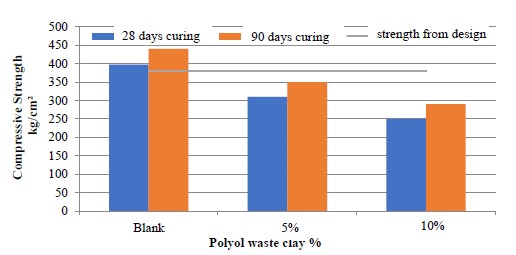 |
||||
| Figure 2. Compressive strength for w/c ratio of 0.45. | ||||
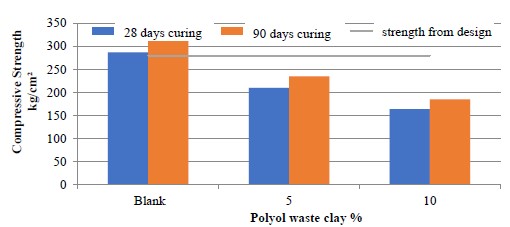 |
||||
| Figure 3. Compressive strength for R a / c 0.60. | ||||
3.6 Capillary sorption
Table 6 shows the results obtained for the main kinetics properties, with the addition of polyol clay the water gain in the concrete (k) decreased; observing an increase in resistance to water penetration m (s/m2). This behavior was evidenced for both w/c ratios (0.45 and 0.60).
In Figure 4 it is observed that the blanks in both w/c ratios are very similar, however, the slopes change drastically for w/c of 0.45 when substituting clay; a marked difference is also noticeably between the mixtures with partial replacement of the polyol waste clay (with w/c 0.45 and 0.60) with regard to the water gain (k); where this value is represented by the slope of the linear region of the curve. With these results it is evident that the use of polyol clay offers greater resistance to water penetration. This property confers a greater resistance to the penetration of aggressive ions such as chloride ion (Cl-). However, the effective porosity (ξ,), slightly increased with the clay content, independent of the w/c ratio; Therefore, it seems that the polyol exerts a hydrophobic effect on the mixture.
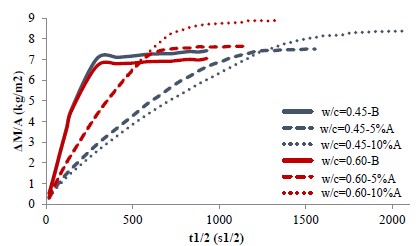 |
||||
| Figure 4. Capillary absorption profile | ||||
| Table 6. Main kinetic properties for capillary sorption. | ||||||||||||||
| w/c (Ratio) | 0.45 | 0.60 | ||||||||||||
|---|---|---|---|---|---|---|---|---|---|---|---|---|---|---|
| Polyol Clay substitution | Blank | 5% | 10% | Blank | 5% | 10% | ||||||||
| k (kg/m2s1/2) | 0.0319 | 0.0117 | 0.0104 | 0.0309 | 0.0169 | 0.0159 | ||||||||
| t1/2, s1/2 | 225 | 613 | 767 | 220 | 440 | 541 | ||||||||
| t, s | 50515 | 375986 | 588773 | 48323 | 194054 | 293858 | ||||||||
| m, s/m2 | 2.02E+07 | 1.50E+08 | 2.36E+08 | 1.93E+07 | 7.76E+07 | 1.18E+08 | ||||||||
| S, m/s1/2 | 2.23E-04 | 8.16E-05 | 6.52E-05 | 2.28E-04 | 1.14E-04 | 9.26E-05 | ||||||||
| ξ, % | 14.3 | 14.3 | 15.9 | 13.6 | 14.9 | 17.3 | ||||||||
3.7 Natural carbonation test results
Figure 5 shows the effect of clay on the natural carbonation rate. It can be seen that the increase in the polyol clay concentration is accompanied by an increase in the carbonation front for the two w/c ratios; which matches the results of effective porosity.
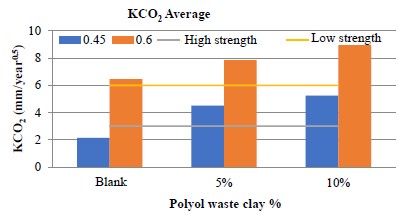 |
||||
| Figure 5. Natural carbonation rate. | ||||
The results in the carbonation chamber (accelerated) were similar to those obtained under natural conditions.
3.8 Potentials and corrosion rates over time for specimens exposed to an accelerated marine environment (ISO 11474).
Figure 6 shows the average corrosion potentials and rates as a function of time, after 350 days of exposure to this accelerated test. Note the beneficial effect of polyol clay on the corrosion rate, where the bars for both w/c ratios were active for the blanks in the time where the specimens with partial substitution of cement for polyol clay were passive. Moreover, when the bars in the specimen with w/c 0.45 were activated, those located in the specimen with w/c 0.60 and polyol waste clay had not yet been activated. This effect was expected, given the greater resistance to water penetration in the clay specimens.
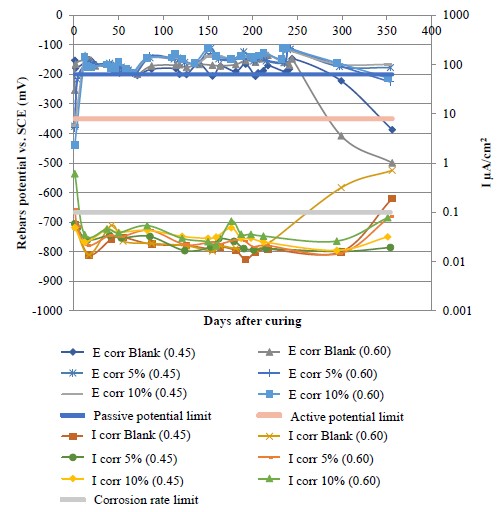 |
||||
| Figure 6. Variation of the corrosion rates and potentials as a function of time, of the steel in the specimens exposed to the ISO 11474 accelerated test. | ||||
3.9 Effect of polyol clay on the Durability of reinforced concrete.
Table 7 collects all the results of the different properties for evaluating the durability of steel in concrete for comparison and analysis; where the green boxes indicate that the limit value recommended by the DURAR manual for each property has not been reached. On the other hand, the red boxes indicate that the property has negatively exceeded the limit established as acceptable and finally a third yellow color code was introduced that indicates an intermediate or regular state of the aforementioned property with respect to the established limit.
At first glance, it is observed that only the blank with w/c 0.45 mostly possesses its properties within acceptable limits, with the exception of capillary sorption which is 2.8 times higher than recommended, which makes it susceptible to the penetration of aggressive ions such as Chloride. However, for the purposes of this investigation this concrete is considered to be of acceptable durability.
For the case of concrete with 5% polyol clay, it was found that it has adequate porosity and its capillary sorption improves compared to that of the blank specimen, which makes it less susceptible to the penetration of chloride ions; where the corrosion rates, which indicate the passive condition of the steel, in these specimens support this assumption. It was determined that the compressive strength is 58 kg/cm2 below the design, however, it is possible to improve this property due to the high extra workability provided by the polyol clay, with a 60% increment compared to that obtained with the blank. That is, it is possible to reduce the amount of mixing water, counting on the workability provided by the polyol clay, with said decrease a substantial increase in compressive strength would be expected due to the decrease in the inherent w/c ratio.
For the mixtures with 10% polyol clay, the electrochemical results show that the bars took longer to activate, a behavior expected in concretes with low capillary sorption such as that exhibited. However, the compressive strength decreases to values as low as 251 kgf/cm2, 130 kgf/cm2 below design. However, again a high workability is noted, 78% higher than that exhibited by the blank. This, as mentioned before, allows a decrease in the mixing water, as a consequence an increase in the compressive strength could be obtained.
For w/c of 0.60 a similar behavior was observed, observing the positive effect of polyol clay substitution on capillary sorption (CS); decreasing it as the % polyol clay in the mix is increased. This effect was manifested when exposing the specimens to an accelerated marine environment (ISO 11474); where these were the last specimens where the rebar was activated.
| Table 7. Summary of the effect of polyol clay on the Durability of the concretes studied during the 356 days of experimentation | ||||||||||||||
| w/c Ratio | Property | Porosity (%) | Capillary Sorption (m/s1/2) | CS (kg/cm2) | KCO2 (mm/a1/2) | % extra-Workability | ||||||||
|---|---|---|---|---|---|---|---|---|---|---|---|---|---|---|
| 0.45 | limit | 10 < ε < 15 | S<0.0000833 | CS≥380 | KCO2 < 3 | - | ||||||||
| Blank | 14.3 | 0.000223 | 407.6 | 2.151 | 0 | |||||||||
| 5% | 14.3 | 0.000082 | 322 | 4.506 | 60 | |||||||||
| 10% | 15.9 | 0.000065 | 251.1 | 5.249 | 78 | |||||||||
| 0.60 | limit | 10 < ε < 15 | S<0.0000833 | CS>=260 | KCO2 < 3 | - | ||||||||
| Blank | 13.6 | 0.000228 | 297 | 6.463 | 0 | |||||||||
| 5% | 14.9 | 0.000114 | 209 | 7.847 | 50 | |||||||||
| 10% | 17.3 | 0.000093 | 166 | 8.949 | 71 | |||||||||
4. Conclusions
5 Acknowledgment
Our most sincere thanks to the company OXITENO ANDINA CA, for the technical support and financial contributions to the development of this research and to the company CEMENTOS CATATUMBO CA, for the technical support provided.
References
American Concrete Institute, always advancing (2002), ACI 211.1-91: Standard Practice for Selecting Proportions for Normal, Heavyweight, and Mass Concrete (Reapproved 2009 ).
ASTM International (2018), C311/C311M-18 Standard test methods for sampling and testing fly ash or natural pozzolans for use in Portland-cement concrete. Retrieved from https://doi.org/10.1520/C0311_C0311M-18.
ASTM International (1989), ASTM C 618-89. Standard specification for fly ash and raw or calcined natural pozzolan for use as a mineral admixture in Portland cement concrete. Section 4, Volume 4.01, 1989, Pp. 296-298. Retrieved from https://doi.org/10.1520/C0618-19
ASTM International (2012), C39/C39M-12a Standard Test Method for Compressive Strength of Cylindrical Concrete Specimens. Retrieved from https://doi.org/10.1520/C0039_C0039M-12A
ASTM International (1999), D512-89(1999) Standard test methods for chloride ion in water. Retrieved from https://doi.org/10.1520/D0512-89R99
ASTM International (2007), E70-07 Standard test method for pH of aqueous solutions with the glass electrode. Retrieved from https://doi.org/10.1520/E0070-07
Calleja, J. (1983). Adiciones y cementos con adiciones. Materiales de construcción. (CSIC), Vol 33, Issue 190-191. Madrid: 25-52.
Devi, S., Gandhi, N., Jat, M., Marmat, N., Manda, B., Vaishnav, M. (2016). Utilization of marble and granite waste as partial replacement of cement in concrete. SSRG International Journal of Civil Engineering (SSRG-IJCE). 3 (5): 193-197. ISSN: 2348-8352.
Fagerlund, G. (1982). “On the Capillarity of Concrete”. Nordic Concrete Research, No. 1, Oslo, Ppe No. 6.
Ghosal, S. (2015). Use of rice husk ash as partial replacement with cement in concrete. International Journal of Engineering Research. 4 (9): 506-509.
Gowsika, D., Sarankokila, S., Sargunan, K. (2014). Experimental investigation of egg shell powder as partial replacement with cement in concrete. International Journal of Engineering Trends and Technology (IJETT). Vol. 14 (2): 65-68. http://dx.doi.org/10.14445/22315381/IJETT-V14P214
ISO (1998). ISO 11474 Corrosion of Metals and Alloys - Corrosion Tests in Artificial Atmosphere - Accelerated Outdoor Test by Intermittent Spraying of a Salt Solution (Scab Test).
Manogna, P., Srilakshmi, M. (2015). Tile powder as partial replacement of cement in concrete. International Research Journal of Engineering and Technology (IRJET). 2(4): 75-77.
Mendoza, K., Millano, V., Troconis, O., Romero, N. (2013). Evaluación de un biopolímero en la calidad del concreto: evaluaciones preliminares. Gaceta Tecnica UCLA. 10:.37-41.
Montiel, M. (2012). “Evaluación de la durabilidad del concreto Armado en ambientes marinos, utilizando escoria de níquel como sustituto parcial de cemento”. Thesis. Universidad del Zulia. Maracaibo. Venezuela.
Normativa ambiental Venezolana reguladora de los desechos de la actividad industrial. (1995). Decreto 883. Gaceta Oficial 5.021 Extraordinario 18/12/1995.
Oxiteno Andina. (2000). Operations manual. Induction program for the production area, Venezuela.
Smaoui, N., Bérubé, M. A., Fournier, B., Bissonnette, B., Durand, B. (2005). Effects of alkali addition on the mechanical properties and durability of concrete ", Cement and Concrete Research. 35:.203- 212. https://doi.org/10.1016/j.cemconres.2004.05.007
Troconis de Rincón, O. et al. (2011). Manual de inspección evaluación y diagnóstico de corrosión en estructuras de concreto armado. Red iberoamericana XV.B (DURAR) 5 Ed. Editorial. Vice Rectorado Académico.
